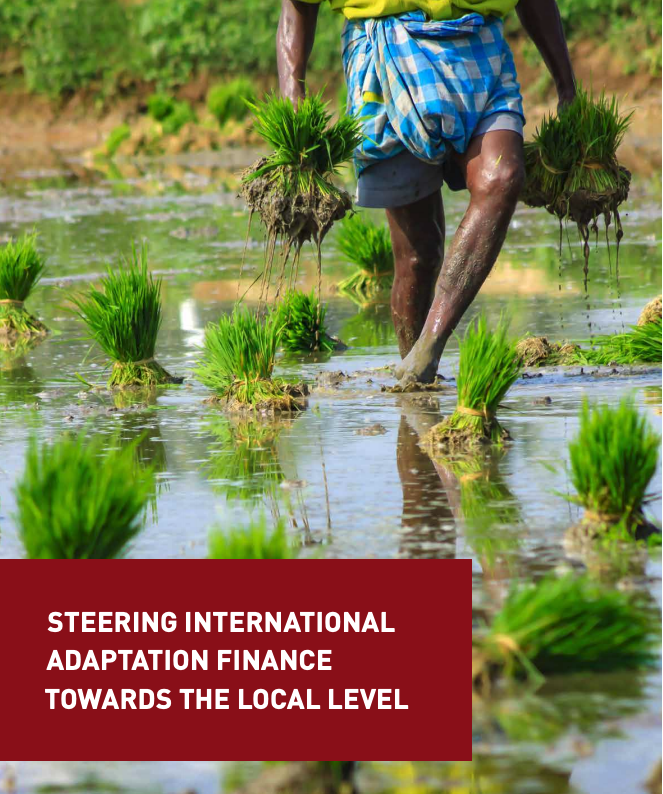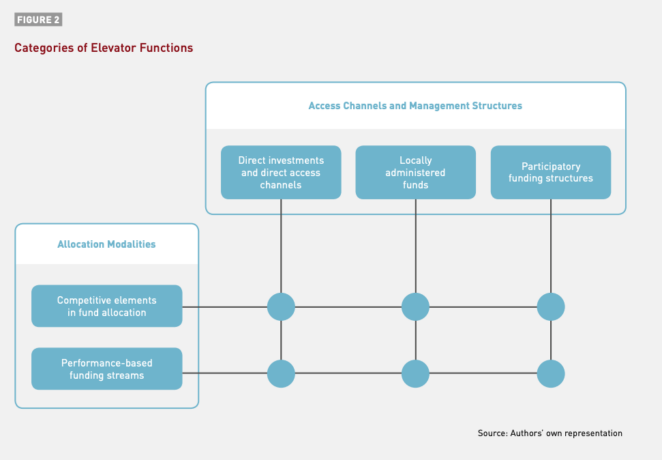Steering International Adaptation Finance Towards the Local Level

Introduction
Climate change adaptation has become a central concern for sustainable development and economic policy, especially in developing countries.
At the same time, financing for adaptation amounted to USD 22 billion in 2016, representing only a small share of tracked climate investments in that year and falling short of projected financing needs.
The provision of climate finance, especially for adaptation needs in vulnerable and local communities, is considered a key element and political goal in the international climate change space.
Effectively steering these resources to the local level (sub-national levels ranging from community- to district-level) where they are most needed and are likely to have the greatest impact remains oftentimes a challenge.
The text below provides an overview of the paper. See the full text for more detail.
Key Challenges
The key challenges for channelling money from the international to the local level can roughly be grouped in three categories:
- Firstly, significant amounts of funding are not efficiently and effectively directed to the local level due to finance being lost on the way in complex processes and a lack of addressing the local level with the money provided.
- Secondly, available funds that are addressed to the local level are not always adapted to local needs.
- Thirdly, there often is a lack of local structures and capacities that prevent local actors from either effectively absorbing dedicated funds or from clearly communicating and raising demand and need for adaptation finance to the allocation decision-makers.
With the provision of finance for adaptation needs in vulnerable and local communities being a key element and political goal of the Paris Agreement, it is in the interest of international donors to have a good understanding of the most effective use of the resources provided for climate change.
This paper aims to provide adaptation finance practitioners, project managers and experts from donor agencies, development finance institutions, multilateral funds, and programmes with a stocktake and analysis of existing specific strategies or operating principles within programmes that aim to channel funding effectively through vertical administrative levels from the international to the local level.
Elevator Functions
“Elevator Functions” are specific strategies or operating principles within programmes whose aim is to channel funding effectively through vertical administrative levels from the international to the local level where finance is meant to unfold maximum impact.
Elevator functions intend to minimise the proportion of funding that gets lost on the way and to maximise the amounts that reach communities, municipalities, and districts with the greatest need for receiving adaptation financing.
Five categories of ‘elevator functions’ that appear to have the greatest potential for effectively reaching specific target groups at the local level:
- Direct investments and direct access channels
- Locally administered funds
- Participatory funding structures
- Funding instruments that allocate funds according to competitive elements
- Performance-based funding

In addition, enabling activities and tools beyond the elevator functions per se that are needed to improve effective channelling of funds to the local level have been identified:
- Local actors should be empowered through the provision of capacity building and technical assistance to local level representatives and organisations
- Grouping and aggregating local level entities as well as developing networks can strengthen their capacity and position through cooperation and collective advocacy.
Next Steps

This paper does not provide fully conclusive results but rather gives a light overview of potentially suitable elements of elevator functions. It should, hence, be the first step for more far-reaching, in-depth research into the identified core aspects. In addition to further research, concrete next steps comprise the consideration of a set of recommendations for action. See full text for more information on further research.
Recommendations for action for adaptation finance practitioners, project managers and experts from donor agencies and multilateral finance institutions include:
When developing funding strategies
- Integrate new elevator functions in existing financing instruments.
- Enhance transformational adaptation finance through the integration of innovative funding principles from other sectors.
- Apply specific thematic or community-prioritised investment windows and fund allocation criteria.
- Consider introducing direct access modalities for entities at community- or district-level.
When deciding on the allocation of financial assets
- Promote local ownership by transferring budget control to local entities.
- Encourage local participation.
- Encourage inclusive and innovative projects through competitive and performance-based funding criteria.
Suggested Citation
Restle-Steinert, Jonas; Tobias Hausotter, Svenja Rudolph, Annica Cochu and Dennis Tänzler (2019): Steering International Adaptation Finance Towards the Local Level. Berlin: adelphi.
Related resources
- Effective financing of climate adaptation measures
- Understanding and increasing finance for climate adaptation in developing countries
- The Roles of the Private Sector in Climate Change Adaptation - an Introduction
- Bottom-Up Innovation for Adaptation Financing – New Approaches for Financing Adaptation Challenges
- Financing from the Ground Up - Experiences in Adaptation Finance from Southeast Asia
- Decentralising climate finance: insights from Kenya and Ethiopia
(0) Comments
There is no content